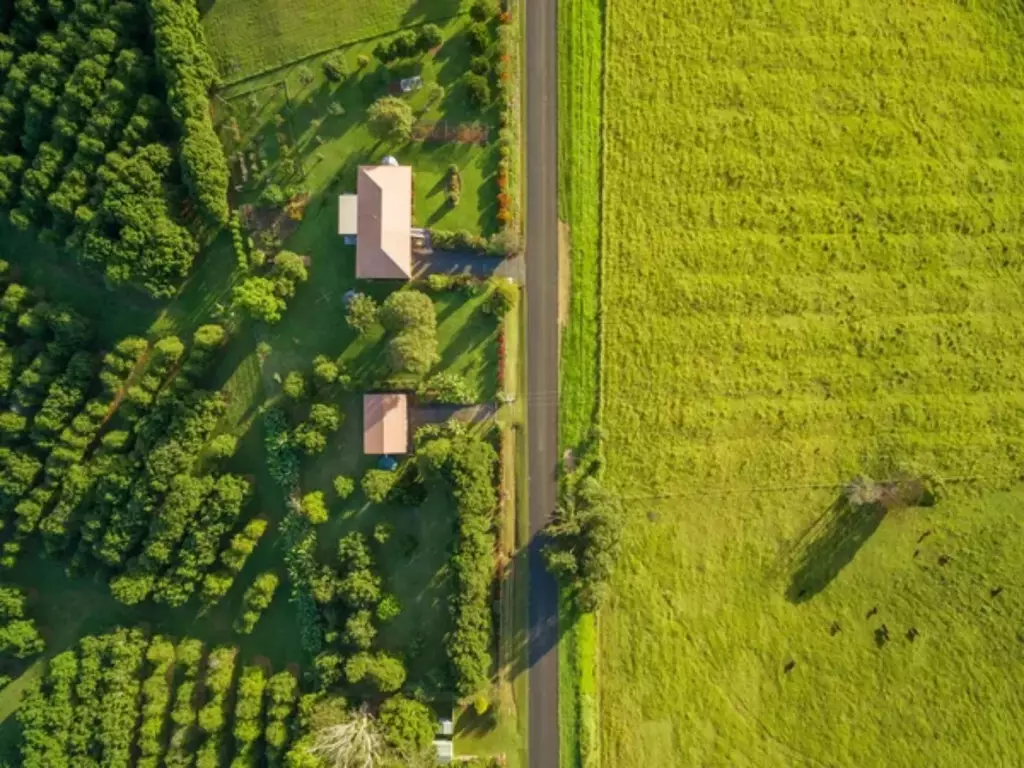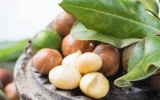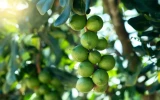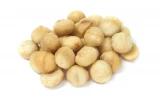Is Macadamia Farming Profitable in 2023? (Full Breakdown)
The macadamia farming industry has been gaining popularity due to the increasing demand for macadamia nuts in various sectors, including food processing, culinary applications, and the beauty industry. In this article, we'll give you a breakdown of the cost and profits of macadamia farming, to distinguish whether it's a profitable venture you can explore.
Macadamia farms can experience little to no profits during the first year, but they can be profitable in the long run. The cost of establishing a new macadamia orchard can range from $51,000 - $83,000 per acre. Meanwhile, operating costs can range from $2,000 to $4,000 per acre each year.
The average yield of an acre of macadamias ranges from 2,000 to 3,000 pounds per acre, with each pound selling between $5 to $8. As you read further, we'll provide you with a calculation of the net profit from macadamia farming.
Planning out a detailed budget for every anticipated cost in starting a macadamia farm is critical preparation and helps ensure you scale properly based on available capital.
Summary
- Macadamia farming is a long-term investment, and it is common for farms to experience initial losses before reaching profitability.
- The cost of establishing a new macadamia orchard ranges from $51,000 - $83,000 per acre and includes costs for land purchase, clearing and preparation, irrigation system, macadamia seedlings, fertilizers and soil amendments, equipment, labor, and miscellaneous expenses.
- Fluctuations in the global supply of macadamia nuts, adverse weather conditions in major producing regions, and market conditions can impact the average price per pound of macadamia nuts.

On this page:
2023 Profit Calculation for Macadamia Farming
| Calculation Factors | Estimated Amount |
|---|---|
| Average yield per acre | 2500 pounds |
| Average price per pound | $6 |
| Initial investment | $67,000 per acre |
| Operating costs per year | $3,000 per acre per year |
To calculate the net profit, you can use the following:
- Revenue = (Average yield per acre) x (Average price per pound)
- Total cost = (Initial investment) + (Operating costs)
- Net profit = Revenue - Total cost
Using the data given, therefore we have the following:
- Revenue = 2500 (average yield per acre) x $6 (average price per pound) = $15,000
- Total cost = $67,000 (initial investment) + $3,000 (operating costs) = $70,000
- Net profit = $15,000 (revenue) - $70,000 (total cost) = -$55,000
Based on these estimated figures, the profit for the first year would be -$55,000.
To calculate the profit margin:
- Profit margin = (Net profit / Revenue) x 100
Using the given data: Net profit = -$55,000 Revenue = $15,000
- Profit margin = (-$55,000 / $15,000) x 100 Profit Margin = -366.67%
Based on these estimated figures, the profit margin for the first year would be -366.67%.
A negative profit margin in the first year of macadamia farming indicates that the expenses incurred in establishing and running the macadamia farm have exceeded the revenue generated from the sale of macadamia nuts. This could be due to various factors such as high initial investment costs, low yields, or unexpected expenses.
Here are some possible reasons for the negative profit:
-
High initial investment: The establishment of a macadamia farm involves significant upfront costs such as land acquisition, infrastructure development, planting of macadamia trees, irrigation systems, and other operational expenses.
-
Low yields: Macadamia trees typically take several years to reach full production capacity. In the first year, the yield of macadamia nuts may be lower than expected, leading to lower revenue and a negative profit.
-
Operating expenses: Operating a macadamia farm involves ongoing expenses such as labor, maintenance, pest control, fertilization, and other operational costs. If these expenses are higher than anticipated, they can contribute to a negative profit in the first year.
-
Market conditions: Fluctuations in market prices for macadamia nuts can impact the profitability of the farm. If the selling price of macadamia nuts is lower than expected, it can result in a negative profit despite reasonable production levels.
A negative profit in the first year of macadamia farming does not necessarily indicate long-term failure. Macadamia farming is a long-term investment, and it is common for farms to experience initial losses before reaching profitability.
It's crucial for farmers to carefully analyze the factors contributing to the negative profit and make informed decisions to improve the financial performance of the farm in subsequent years.
This may involve adjusting farming practices, optimizing resource allocation, and closely monitoring expenses to achieve profitability in the long run. If you're running out of ideas, we rounded up 9 tips to help you boost the profits of your macadamia farm.
Initial Costs for Macadamia Farming in 2023
The cost of establishing a new macadamia orchard can range from $51,000 - $83,000 per acre, depending on factors such as the following:
| Expense Category | Estimated Cost |
|---|---|
| Land purchase | $10,000 - $20,000 |
| Clearing and preparation | $5,000 - $10,000 |
| Irrigation system | $15,000 - $20,000 |
| Macadamia seedlings | $2,000 - $3,000 |
| Fertilizers and soil amendments | $1,000 - $2,000 |
| Equipment (e.g., tractor, sprayer) | $10,000 - $15,000 |
| Labor | $5,000 - $8,000 |
| Miscellaneous expenses | $3,000 - $5,000 |
| Total | $51,000 - $83,000 |
Land purchase costs around $10,000 - $20,000
The location of the land plays a significant role in determining its price. Land situated in regions with suitable climate and soil conditions for macadamia cultivation, as well as proximity to necessary infrastructure such as water sources and transportation routes, tends to command higher prices.
Additionally, larger parcels of flat or gently sloping land are generally more desirable for efficient farming practices and may therefore be more expensive. The presence of existing infrastructure, such as irrigation systems or fencing, can also contribute to the higher cost of the land.

Furthermore, in areas where macadamia farming is established and profitable, the competition for available land can drive up prices. Regulatory factors, such as zoning restrictions and land use regulations, can also affect land prices.
When choosing the best spot for your macadamia farm, there are tips in this article that you might find useful.
The cost of clearing and preparation ranges from $5,000 to $10,000
Land that requires extensive clearing of trees, shrubs, and other vegetation, as well as leveling of the terrain, will incur higher expenses compared to land that is already cleared and relatively flat.
Moreover, the method of clearing, whether through manual labor or mechanized equipment, can also affect the cost. Manual clearing may be more time-consuming and labor-intensive, potentially leading to higher expenses.
In contrast, the use of heavy machinery for land clearing can expedite the process but may incur higher upfront costs.
Additionally, the cost of preparing the land for macadamia farming includes activities such as soil testing, soil amendment application, and initial land grading.
Furthermore, compliance with environmental regulations, such as erosion control measures and protection of natural habitats, can add to the expenses associated with land preparation.
The estimated cost of an irrigation system ranges from $15,000 to $20,000
Larger orchards with extensive acreage will naturally require a more complex and extensive irrigation network, leading to higher costs.
Additionally, the topography of the land, including slopes and elevation changes, can impact the design and installation of the irrigation system, potentially adding to the overall expense.

The type of irrigation system chosen also plays a role in the cost variation. Drip irrigation, for example, is more precise and efficient but may require a higher initial investment compared to traditional sprinkler systems.
The choice of irrigation technology, such as automated controls and monitoring systems, can further contribute to the overall cost.
Moreover, depending on the water quality, additional equipment or infrastructure may be required to ensure that the irrigation water meets the specific needs of macadamia trees.
Furthermore, the cost range also accounts for expenses related to installation, including labor, materials, and any necessary permits or regulatory compliance.
Macadamia seedlings cost around $2,000 to $3,000
High-quality, disease-free, and well-established macadamia seedlings typically command a higher price due to their potential for better growth and productivity.
Additionally, the specific variety or cultivar of macadamia seedlings can also influence the cost, with certain varieties being more sought after or having specific traits that justify a higher price. If you're still unsure which variety to go for, this comparison of the best macadamia varieties might help.
Furthermore, older, more mature seedlings may be more expensive due to the time and resources invested in their growth prior to sale. Larger seedlings may also require more resources for transportation and handling, contributing to the overall cost.
Certified nurseries or reputable suppliers that provide healthy and genetically diverse macadamia seedlings may also charge a premium for their products, reflecting the assurance of quality and reliability.
In addition, factors such as transportation, handling, and any guarantees or warranties provided by the supplier may also contribute to the overall cost range for macadamia seedlings.
The estimated cost for fertilizers and soil amendments is $1,000 to $2,000
Soil testing and analysis may reveal deficiencies or imbalances in key nutrients, necessitating the application of specific fertilizers and soil amendments to address these issues.
Organic fertilizers and soil amendments, while beneficial for long-term soil health and sustainability, may require a higher initial investment compared to synthetic options.
Furthermore, larger orchards or those with more intensive nutrient requirements may necessitate a higher volume of fertilizers and soil amendments, leading to increased expenses. Moreover, the need for multiple applications throughout the growing season can add to the overall cost.
The cost range also considers factors such as transportation, storage, and application methods for fertilizers and soil amendments. Specialized equipment or professional application services may incur additional expenses.
Equipment costs around $10,000 to $15,000
Larger and more powerful machinery, such as tractors with various implements or specialized sprayers, may command a higher price due to their capabilities and capacity to efficiently manage larger orchards.
New or well-maintained machinery may require a higher initial investment but can offer reliability and performance advantages. Conversely, used or refurbished equipment may present cost-saving opportunities but could entail potential maintenance or operational considerations.
Furthermore, the specific features and technology integrated into the equipment, such as precision agriculture capabilities or ergonomic design, can contribute to the overall cost range.
Labor costs between $5,000 to $8,000
Tasks such as land preparation, planting, irrigation system installation, pruning, pest and disease management, and harvest all require labor at different stages throughout the year, impacting the total labor expense.
Additionally, the skill level and experience of the labor force can impact the cost range. Specialized tasks such as grafting, orchard management, and equipment operation may require skilled labor, potentially commanding higher wages or salaries.
Furthermore, the duration and intensity of labor requirements throughout the year also contribute to the cost range. Seasonal variations in workload, such as peak periods during planting or harvest, may necessitate additional labor and impact the overall expense.

Miscellanuous expenses may arise up to $3,000 to $5,000
Regulatory and administrative expenses, such as permits, licenses, and compliance fees, may contribute to the miscellaneous expenses.
Navigating local regulations and obtaining necessary approvals for land use, water rights, and environmental compliance can incur costs that fall under this category.
Additionally, costs related to legal and professional services, such as consulting fees, accounting, and legal advice, may be included in the miscellaneous expenses.
Expert guidance and professional assistance in areas such as business planning, financial management, and legal compliance can add to the overall cost.
Furthermore, the purchase of small tools, safety equipment, and general supplies needed for orchard maintenance and operation may also be considered as miscellaneous expenses. These items can include hand tools, personal protective equipment, signage, and other essential supplies for day-to-day activities.
Contingency funds for unforeseen repairs, emergency services, or other unanticipated needs are also often included in this category to ensure financial preparedness.
Total Revenue From Macadamia Farming
The table below provides a comprehensive overview of the estimated market price per pound and average yield per acre for different varieties of macadamia nuts:
| Macadamia Variety | Estimated Market Price per Pound (USD) | Average Yield per Acre (lbs) |
|---|---|---|
| Beaumont | $5.00 | 3,000 |
| A4 | $4.50 | 2,800 |
| 344 | $4.75 | 2,600 |
| 246 | $5.25 | 2,900 |
The average yield of macadamia nuts per acre
Typically, the average yield of an acre of macadamias ranges from 2,000 to 3,000 pounds per acre. Several factors can influence the yield of macadamia nuts, including climate, soil quality, irrigation, and pest management.
Macadamia trees thrive in subtropical regions with moderate temperatures and well-distributed rainfall. A consistent climate with minimal temperature fluctuations and adequate moisture levels is conducive to higher yields.
Well-drained, fertile soils with good water retention capacity and proper aeration are ideal for macadamia tree growth. Soil pH, nutrient levels, and organic matter content also play a vital role in determining the productivity of macadamia orchards.
Similarly, adequate water supply during critical growth stages, particularly during flowering and nut development, is crucial for maximizing yields. Proper irrigation scheduling and efficient water management practices can significantly influence the productivity of macadamia orchards.
Effective pest and disease management is necessary to protect macadamia trees from potential threats that can impact yields. Pests such as macadamia nut borer and diseases like phytophthora can negatively affect nut production if not managed effectively.
Different macadamia species also have varying yield potentials. You can learn more about the average nut yield for different macadamia species in this article.
Estimated market value and price of different macadamia varieties
The average price of macadamia nuts per pound typically falls within the range of $5 to $8. This price range can fluctuate due to several factors that influence the market for macadamia nuts.
Macadamia nuts are primarily grown in regions such as Australia, Hawaii, and parts of Africa. Fluctuations in the global supply of macadamia nuts can impact the average price per pound.
For example, adverse weather conditions in major macadamia nut-producing regions can lead to reduced harvests, which can in turn drive up prices.

The quality of the macadamia nuts also plays a significant role in determining their price. Factors such as size, flavor, and overall appearance can affect the market value of the nuts.
Higher-quality macadamia nuts often command a premium price, while lower-quality nuts may be sold at a lower price point.
Market conditions, both domestic and international, also influence the average price of macadamia nuts. Economic factors, consumer preferences, and trade policies can all impact the demand for macadamia nuts and subsequently affect their price.
For example, an increase in consumer demand for healthy snacks or a surge in popularity of macadamia-based products can drive up prices.



